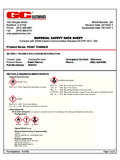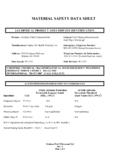Transcription of SAFETY DATA SHEET Date of Preparation: July 21, …
1 dimethyl sulfoxide (DMSO)Date of Preparation: July 21, 2016 SAFETY DATA SHEET Page 1 of 11 Product Name: dimethyl sulfoxide (DMSO) Synonyms: Enviro S, dimethyl sulphoxide, methyl sulfoxide , sulfinylbis [methane]. Product Use: Solvent for manufacture of pharmaceuticals, fine chemicals and polymers. Restrictions on Use: Not available. Manufacturer/Supplier: Valhoma Corporation 1617 N. 93rdEastAve. Tulsa, OK 74115 United States Emergency Phone: CHEMTREC (USA): (800) 424-9300 Customer Service: Valhoma Corporation: (918) 836-7135 (8:00am - 5:00pm CST) Date of Preparation of SDS: July 21, 2016 GHS INFORMATION Classification: Flammable Liquids, Category 4 LABEL ELEMENTS Hazard Pictogram(s): None. Signal Word: Warning Hazard Statements: Combustible liquid. Precautionary Statements Prevention: Keep away from heat, hot surfaces, sparks, open flames and other ignition sources.
2 No smoking. Wear protective gloves, protective clothing and eye protection. Response: In case of fire: Use dry chemical, CO2, water spray or regular foam to extinguish. Storage: Store in a well-ventilated place. Keep cool. Disposal: Dispose of contents/container in accordance with applicable regional, national and local laws and regulations. Hazards Not Otherwise Classified: Not applicable. Ingredients with Unknown Toxicity: None. This material is considered hazardous by the OSHA Hazard Communication Standard, (29 CFR ). Section 1: IDENTIFICATION Section 2: HAZARD(S) IDENTIFICATION dimethyl sulfoxide (DMSO)Date of Preparation: July 21, 2016 SAFETY DATA SHEET Page 2 of 11 This material is considered hazardous by the Hazardous Products Regulations. Hazardous Ingredient(s) Common name / Synonyms CAS No.
3 % , 1,1'-sulfinylbis- dimethyl sulfoxide ; DMSO67-68-5 75 -100 Impurities / Stabilizing additives: None known. Inhalation: If inhaled: Call a poison center or doctor if you feel unwell. Acute and delayed symptoms and effects: May cause respiratory irritation. Signs/symptoms may include cough, sneezing, nasal discharge, headache, hoarseness, and nose and throat pain. Exposure to high concentrations of dimethyl sulfoxide could cause lowering of consciousness. Repeated exposure to DMSO vapors did not cause any irritation to the respiratory tract; however the exposure to high concentrations in the form of an aerosol induced an irritation of the upper airways after a repeated exposure. Eye Contact: If in eyes: Rinse cautiously with water for at least 15 minutes. Remove contact lenses, if present and easy to do.
4 Continue rinsing. Call a poison center or doctor if you feel unwell. Acute and delayed symptoms and effects: May cause eye irritation. Signs/symptoms may include redness, swelling, pain, tearing, and blurred or hazy vision. DMSO is slightly irritating for the eye. In studies performed following the OECD 405 or the EEC method , a slight to moderate conjunctival irritation, which cleared in 3 days, was observed in the eyes of rabbits. In humans, the instillation of solutions containing 50 to 100% DMSO has caused transient sensation of burning which was reversible within 24 hours. Skin Contact: If on skin (or hair): Take off immediately all contaminated clothing. Rinse skin with water or shower. Call a poison center or doctor if you feel unwell. Acute and delayed symptoms and effects: May cause skin irritation.
5 Signs/symptoms may include localized redness, swelling, and itching. dimethyl sulfoxide may accelerate skin absorption of other materials. A skin irritation assay performed in rabbit (OECD 404) revealed no more than a very slight or well-defined erythema, which disappeared in 3 days. Ingestion: If swallowed: Call a poison center or doctor if you feel unwell. If vomiting occurs naturally, have victim lean forward to reduce the risk of aspiration. Do NOT induce vomiting unless directed to do so by medical personnel. Never give anything by mouth to an unconscious person. Acute and delayed symptoms and effects: May cause gastrointestinal irritation. Signs/symptoms may include abdominal pain, stomach upset, nausea, vomiting and diarrhea. Section 3: COMPOSITION / INFORMATION ON INGREDIENTS Section 4: FIRST-AID MEASURES dimethyl sulfoxide (DMSO)Date of Preparation: July 21, 2016 SAFETY DATA SHEET Page 3 of 11 General Advice: In case of accident or if you feel unwell, seek medical advice immediately (show the label or SDS where possible).
6 Note to Physicians: Symptoms may not appear immediately. FLAMMABILITY AND EXPLOSION INFORMATION Combustible liquid. Will be ignited by heat, sparks or flames. Vapors may form explosive mixtures with air. Vapors will spread along ground and collect in low or confined areas (sewers, basements, tanks). Containers may explode when heated. Sensitivity to Mechanical Impact: This material is not sensitive to mechanical impact. Sensitivity to Static Discharge: This material is sensitive to static discharge. MEANS OF EXTINCTION Suitable Extinguishing Media: Small Fire: Dry chemical, CO2, water spray or regular foam. Large Fire: Water spray, fog or regular foam. Move containers from fire area if you can do it without risk. Unsuitable Extinguishing Media: Do not use straight streams. Products of Combustion: Oxides of carbon.
7 Oxides of sulphur. Protection of Firefighters: Fire may produce irritating, corrosive and/or toxic gases. Vapors may cause dizziness or suffocation. Runoff from fire control or dilution water may cause pollution. Wear positive pressure self-contained breathing apparatus (SCBA). Structural firefighters' protective clothing will only provide limited protection. Emergency Procedures: As an immediate precautionary measure, isolate spill or leak area for at least 50 meters (150 feet) in all directions. Keep unauthorized personnel away. Stay upwind. Keep out of low areas. Ventilate closed spaces before entering. ELIMINATE all ignition sources (no smoking, flares, sparks or flames in immediate area). All equipment used when handling the product must be grounded. Personal Precautions: Do not touch or walk through spilled material.
8 Use personal protection recommended in Section 8. Environmental Precautions: Prevent entry into waterways, sewers, basements or confined areas. Methods for Containment: Stop leak if you can do it without risk. A vapor suppressing foam may be used to reduce vapors. Methods for Clean-Up: Absorb or cover with dry earth, sand or other non-combustible material and transfer to containers. Use clean non-sparking tools to collect absorbed material. Other Information: See Section 13 for disposal considerations. Section 5: FIRE-FIGHTING MEASURES Section 6: ACCIDENTAL RELEASE MEASURES dimethyl sulfoxide (DMSO)Date of Preparation: July 21, 2016 SAFETY DATA SHEET Page 4 of 11 Handling: Do not swallow. Avoid breathing mist, vapours, or spray. Keep away from heat, hot surfaces, sparks, open flames and other ignition sources.
9 No smoking. Keep container tightly closed. Ground and bond container and receiving equipment. Use non-sparking tools. Take action to prevent static discharges. See Section 8 for information on Personal Protective Equipment. Storage: Store in a well-ventilated place. Keep cool. Store away from incompatible materials. See Section 10 for information on Incompatible Materials. Keep out of the reach of children. Exposure Guidelines Component dimethyl sulfoxide (DMSO) [CAS No. 67-68-5] ACGIH: No TLV established. OSHA: No PEL established. PEL: Permissible Exposure Limit TLV: Threshold Limit Value Engineering Controls: Use explosion-proof electrical, ventilating, and lighting equipment. PERSONAL PROTECTIVE EQUIPMENT (PPE) Eye/Face Protection: Wear SAFETY glasses with side shields. Use equipment for eye protection that meets the standards referenced by CSA Standard and OSHA regulations in 29 CFR for Personal Protective Equipment.
10 Hand Protection: Wear protective gloves. Butyl or nitrile rubber gloves are recommended. Consult manufacturer specifications for further information. Skin and Body Protection: Wear protective clothing. Flame resistant clothing that meets the NFPA 2112 and CAN/CGSB standards is recommended in areas where material is stored or handled. Respiratory Protection: Not required under normal use conditions. If ventilation is inadequate then an appropriate NIOSH/MSHA approved air- purifying respirator that meets the requirements of CSA Standard , with organic vapor cartridge, or self-contained breathing apparatus must be used. Supplied air breathing apparatus must be used when oxygen concentrations are low or if airborne concentrations exceed the limits of the air-purifying respirators. Section 7: HANDLING AND STORAGE Section 8: EXPOSURE CONTROLS / PERSONAL PROTECTION dimethyl sulfoxide (DMSO)Date of Preparation: July 21, 2016 SAFETY DATA SHEET Page 5 of 11 General Hygiene Considerations: Handle according to established industrial hygiene and SAFETY practices.





